The 10 Best Running Shoes of 2022, According to Experts

If you purchase an independently reviewed product or service through a link on our website, Footwear News may receive an affiliate commission.
I’ve been a runner for over 25 years, running coach for ten years and running shoe reviewer since 2014. Each year I get the opportunity to test between 40 and 70 pairs of shoes from every major brand. In all my shoe testing experience, I’ve come to understand one undeniable fact about running shoes: There’s no such thing as lousy running shoes. If someone dislikes a shoe, it’s because it isn’t a good fit for them. After all, there’ll always be another runner who loves that same shoe. Finding the best running shoe for you boils down to matching the type of running shoe to what you need and like and how you’ll be using your pair. The search is easier said than done, but when armed with a bit of knowledge and insider information from review stories like this one, finding the perfect running shoe to keep your feet comfortable is pretty simple.
More from Footwear News
The 10 Best Long-Distance Running Shoes, According to a Distance Running Coach
Nike Utilizes ZoomX Tech in New Lightweight Streakfly Running Sneaker for Shorter Races
The 35 Best Workout Shoes for Every Type of Fitness Exercise
Types of running shoes
While most running shoes look similar, subtle, and often unnoticeable, differences in the materials and design can make one shoe very different from another. Some shoes are designed for speed and racing, while others are built for easy running. Some are more supportive, while others are flexible.
As we walk and run, our feet and ankles have a natural movement pattern or pronation to them. Some people exhibit excess inward or outward movement that places abnormal stress on their ankles, knees and hips. This can potentially lead to injury and make one type of shoe more comfortable than another, so finding the right pair that suits your foot type is key.
Neutral Shoes: Runners whose ankles roll inward 15 degrees or less have neutral pronation. Neutral running shoes are typically more flexible and made without firm structural elements to control the foot’s pronation.
Stability Running Shoes: Runners whose ankles and arches roll in excess of 15 degrees inward and downward overpronate. Stability shoes are typically stiffer than neutral shoes and built with firm, supportive elements such as a medial post and heel counter to control the excess inward movement.
Carbon Fiber Shoes: These are typically primarily designed for speed workouts and racing, featuring a carbon fiber plate sandwiched in the midsole. The carbon fiber plate adds rigidity and can work in unison with the midsole to increase your running economy.
Maximum Cushioned Shoes: These shoes have a thick midsole that can be quantified with the stack height measurement. The stack height measures the material between your foot and the ground, and it can be characterized by a soft or plush underfoot feeling.
Minimalist Shoes: These are shoes with a very thin midsole and high ground sensitively. They are often referred to as “barefoot shoes.”
Lightweight Shoes: These are primarily designed for speed workouts and racing. While there is no hard and fast rule on weight, a running shoe would be considered lightweight if it’s under nine ounces for men and 8.5 ounces for women. They tend to be less durable than heavier running shoes, so it’s best to use them sparingly or replace them more often.
Trail Shoes: These are running shoes designed for off-road running, such as trails, dirt paths and mountainous terrain. The outsole or bottom of the shoe features lugs for better traction. Some trail shoes will have a plastic plate in the midsole called a rock plate to protect your foot from jagged rocks and trail debris.
Top 10 Running Shoes
Best Overall Running Shoes: Asics Gel-Nimbus Lite 3
Best Trail Running Shoes: Salomon Sense Ride 4
Best Stability Running Shoes: Asics Gel-Kayano 28
Best Cushioned Running Shoes: Adidas Ultraboost 22
Best Running Shoes for Wide Feet: Brooks Ghost 14 Wide
Best Carbon Fiber Plate Running Shoes: Asics Metaspeed Sky
Best Marathon Racing Shoes: Nike Air Zoom Alphafly Next%
Best for Speed Running: Skechers Speed Freak
Best Budget: Saucony Axon
Best Cushioned Trail Shoes: Hoka One One Speedgoat 4
What to look for in running shoes
The first step in buying a running shoe is determining how you’ll use it. Start by asking yourself whether you’ll be running primarily on roads or trails. Once you’ve determined whether you need a road or trail shoe, there are two main things to consider when shopping for the right pair: Feel and fit.
Feel: I’ve had the opportunity to speak with many experts on this very topic, and they all agree that “the number one driver of what seems to work is comfort,” explains one such expert, California-based physical therapist Dr. David Salas. He says finding a running shoe that is comfortable and fits well is crucial, since every runner has different needs, and foot patterns will dynamically change while running.
According to Brian Crispell, D.P.M., a board certified surgeon with the American Board of Foot and Ankle Surgery, it’s typically best to avoid shoes that are “overly twisty and bendy,” he says. Instead, he recommends looking for features like a sturdy heel cup, multi-density EVA midsoles and a mid-foot truss or bridge that stabilizes the shoe.
And if you’re ever in doubt, trust your instincts. Move on if a shoe feels off or uncomfortable the first time you put it on.
Fit: In terms of fit, a (literal) rule of thumb is to have a thumb’s width worth of space between your leading toe and the end of the shoe. For width, the sides of your feet should not be bulging out the sides of the uppers. If you’ve historically gotten holes in your uppers, that’s usually a sign you may need wider shoes. Most shoe companies will offer their top-selling shoes in wide and narrow versions. If you’re worried about not being able to try on shoes before you buy them online, the good news is that most companies offer a 30 to 90-day return policy if you get them to your door and decide they’re not the right fit.
And as we previously mentioned, reading online buyer’s guides like this one can be a powerful tool for finding the perfect running shoe for your needs. Because my team and I have had the opportunity to run in so many different pairs of shoes, we can sort through each type of shoe to find the best for each use case. For example, we’ve identified the best running shoe for runners who suffer from particular ailments such as plantar fasciitis or flat feet. We’ve also sorted through the best running shoes from some of the leading brands like Nike, Asics and Adidas. Here’s a rundown of those individual buyer’s guides to assist your search:
How we test running shoes
To help with testing, I employed a team of 16 runners composed of recreational and competitive runners, trail and road runners, running store owners and former running shoe brand employees. Collectively, we put these shoes through the hundreds of miles of wear. Each tester ranks a shoe on a numerical scale and writes a 300- to 500-word synopsis on it. I use this feedback, alongside my own testing, to pick the best running shoes you see below.
Asics Gel-Nimbus Lite 3 Running Shoes
Best Overall Running Shoes
The Asics formula that produced some of the best shoes of the ’90s and ‘00s doesn’t have the same appeal to modern-day runners, who now have high expectations for their footwear. As one of my testers put it, they want styles that are “lightweight, well-cushioned and comprised of a compound that is neither too soft nor too firm.” Over the past two years, however, Asics has re-emerged in the running shoe category with some standout models that deliver on all three fronts, namely the Asics Gel-Nimbus Lite 3. Not only does it achieve this trifecta that few other running shoes on the market are able to accomplish, but it was also unanimously ranked as the best running shoe by all my testers. In fact, no other shoe came close.
“Out of the box, the Nimbus Lite 3 was comfortable and bouncy,” said one tester. “It delivers the sort of reliability and good quality you want from a running shoe; it’s designed to break the mold.” The medium stack height (25 millimeter/15 millimeter) Flytefoam midsole with rearfoot and forefoot Gel cushioning strikes the perfect balance between soft cushioning and responsiveness, offering a shoe that’s equally suited for easy runs and uptempo days. As one tester noted, “It feels like there’s enough cushion for earnest training but in a light enough package for workouts or even races, if you’re inclined to go fast but want some extra protection.”
The engineering marvel also has a lightweight mesh upper made with 60% recycled polyester that’s breathable yet secure and a full ground contact outsole with flex grooves for a smooth transition from landing to toe-off. Together, these features make the shoe feel like a natural extension of your feet (which is a key component of some of the best running shoes you can buy).
Specs:
Weight 9.2oz (men); 8.1oz women
Stack Height: 25mm/ 15mm (men), 27mm/ 14mm (women)
Drop: 10mm (men), 13mm (women)

Courtesy of Amazon
Buy:
Asics Men's Gel-Nimbus Lite 3
$160
Buy:
Asics Women's Gel-Nimbus Lite 3
$160
Salomon Sense Ride 4 Running Shoes
Best Trail Running Shoes
There isn’t a trail shoe on the market with better terrain versatility and competence than Salomon’s Sense Ride 4. Sure, you could buy one shoe for every type of trail terrain you encounter, or you could just buy the Sense Ride 4 and call it a day. As one reviewer so perfectly summed up, “If you’re looking for one pair of shoes to go with, the Sense Ride 4’s are your shoe. The shoe is fantastic for technical trails, long days in the mountains or even running roads from your doorstep over to your local trails.”
The Sense Ride 4 is what you would expect from an all-around trail shoe in terms of stats. There’s nothing too aggressive that would exclude a runner based on experience or terrain preferences. The 32 millimeter/24 millimeter stack height is thick enough for adequate underfoot protection and comfortable cushioning, yet not so tall that it feels tipsy enough to roll an ankle. The Obtivibe midsole features two foams that work in unison: one to dampen each footstrike and one to propel you forward. I felt just as comfortable cruising in these on smooth trails as I did ripping down technical and rocky mountainsides — a true mark of a well-rounded trail shoe.
The Sense Ride 4 features Salomon’s QuickLace System, a patented tug and pull system for easy adjustments on the fly. For the most part, testers appreciated the ease with which they could loosen or tighten the laces. The one gripe our more aggressive testers expressed about these shoes was that achieving secure forefoot lockdown was tough. Still, for the majority of trail runners, you’d be hard-pressed to find a better and more capable trail runner than the Salomon Sense Ride 4.
Specs:
Weight 10.2oz (men); 8.3oz women
Stack Height: 32mm/ 24mm
Drop: 8mm

Courtesy of Amazon
Buy:
Salomon Men's Sense Ride 4
$118-$258
Buy:
Salomon Women's Sense Ride 4
$116-$258
Asics Gel-Kayano 28 Running Shoes
Best Stability Running Shoes
For decades, the Asics Gel-Kayano has been considered the gold standard of stability shoes. Its sturdy platform and supportive upper hold your foot firmly in place to prevent excess overpronation. Underfoot, the Gel-Kayano has historically erred on the firmer end of the spectrum. However, recently the ride has softened. As one long-time Asics wearer noted, “I’ve been wearing Asics since the early 90’s when I ran in college. In my opinion, this may be their best shoe yet. Fit and stability are similar to previous Asics Kayanos, but the cushioning feels better.”
The softer ride is due to the addition of an FF Blast midsole, featuring an energetic and highly responsive cushioning also seen in Asics’ maximum cushioning shoe, the NovaBlast 3. To help with pronation, Asics Duomax foam, which is slightly firmer, is placed on the medial side. Asics Gel Technology is added to the forefoot and rearfoot for additional shock absorption and spring take-offs. 3D Space Construction located in the heel on the men’s models and the forefoot on the women’s models allow for greater compression and cushioning at toe-off and accounts for differences in gender — something more shoes should consider.
If you need a supportive shoe for things like overpronation, flat feet, arch support or plantar fasciitis, do yourself a favor and invest in Asics’ Gel-Kayano 28. With these, there’s a good chance your search for the perfect running shoe will come to an end, as so many Gel-Kayano coverts have found.
Specs:
Weight 10.9oz (men); 9.1oz women
Stack Height: 23mm/ 13mm
Drop: 10mm

Courtesy of Amazon
Buy:
Asics Men's Gel-Kayano 28
$129-$298
Buy:
Asics Women's Gel-Kayano 28
$122-$298
Adidas Ultraboost 22 Running Shoes
Best Cushioned Running Shoes
For those who value comfort over all else, treat your feet to the luxury of adidas’ Ultraboost 22. Perhaps the best adidas running shoes ever created, the newly updated Ultraboost 22 continues the company’s legacy of pairing plush underfoot cushioning with high energy return for an unmistakably pleasurable experience. The highlight of the shoe is undoubtedly its full-length adidas Boost midsole, a TPU-based midsole that the brand’s website describes as running on “tiny, precision-engineered clouds” with “the power to absorb and return more of an athlete’s kinetic output.”
All that cushioning and comfort does come at the expense of weight. The Ultraboost 22 tips the scales at a hefty 11.9 ounces for both men and women, making it more suitable for everyday running and long runs over speed sessions and races.
Comfort isn’t just reserved for underfoot, however. The Primeknit+ upper that’s made with 50% recycled polyester and 50% Parley Ocean Plastic feels and fits like your softest pair of socks. Plastic overlays and a firm heel counter add a touch of structure to the stretchy upper, holding your heel and foot steady throughout the gait cycle.
The biggest update over the Ultraboost 21 comes in the way of a female-focused design. It was created by an all-woman team that used 1.2 million foot scans to re-engineer the fit specifically for the female foot. Gabrielle PorcaroI, one of our female testers who put the new Ultraboost 22 to the test, notes that she will “definitely be lacing these up regularly and would recommend them to any female runners looking for a new shoe.” Regardless of sex, age or ability level, the Ultraboost 22 will take the sting out of all that concrete pounding.
Specs:
Weight 11.9oz (men); n/a women
Stack Height: 33mm/ 23mm
Drop: 10mm
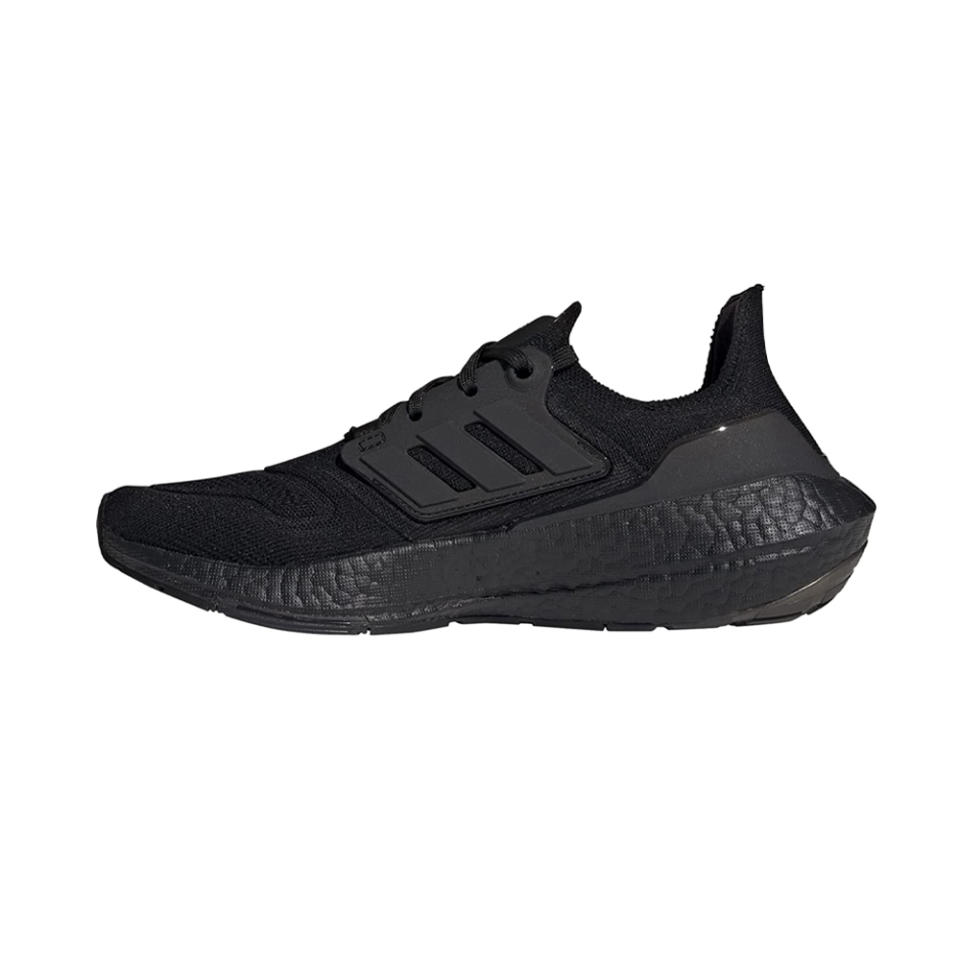
Courtesy of Amazon
Buy:
Adidas Men's Ultraboost 22
$145-$324
Buy:
Adidas Women's Ultraboost 22
$134-$324
Brooks Ghost 14 Wide Running Shoes
Best Running Shoes for Wide Feet
I’m going to let you in on a lesser-known fact about running shoes: Most brands offer their best-selling models in wide widths, and some even in extra-wide widths. So, if you have wide feet, you don’t need to limit your running shoe choices to brands like Altra or Topo that naturally have a wider toe box. Runners with wide feet can get the best of both worlds with the Brooks Ghost 14 in wide or extra wide. As one of the best all-around workhorse neutral trainers on the market, the Brooks Ghost 14 is ideal for pounding out mile after mile.
Ghost loyalists will notice a slightly softer underfoot experience with the 14th iteration thanks to a full-length DNA Loft midsole that replaces the dual-density midsole found on the Ghost 13. As one reviewer noted, “The new foam is fantastic. I always thought that Brooks had the perfect blend of cushioning and rebound, but these are even better. They feel just as soft but with noticeably more ‘pop’ on the rebound.” The outsole still has a segmented crashpad for optimal flexibility from a smooth landing to toe-off.
Using Brooks’ 3D Fit Print screen-printing technology to create a soft yet flexible feel, the redesigned upper was found to fit well and provide a good amount of comfort, according to testers. Environmentally-conscious runners will also enjoy knowing the Ghost 14 is Brooks’ first carbon-neutral running shoe.
Specs:
Weight 10.0oz (men); 8.8oz women
Stack Height: 36mm/ 24mm
Drop: 12mm
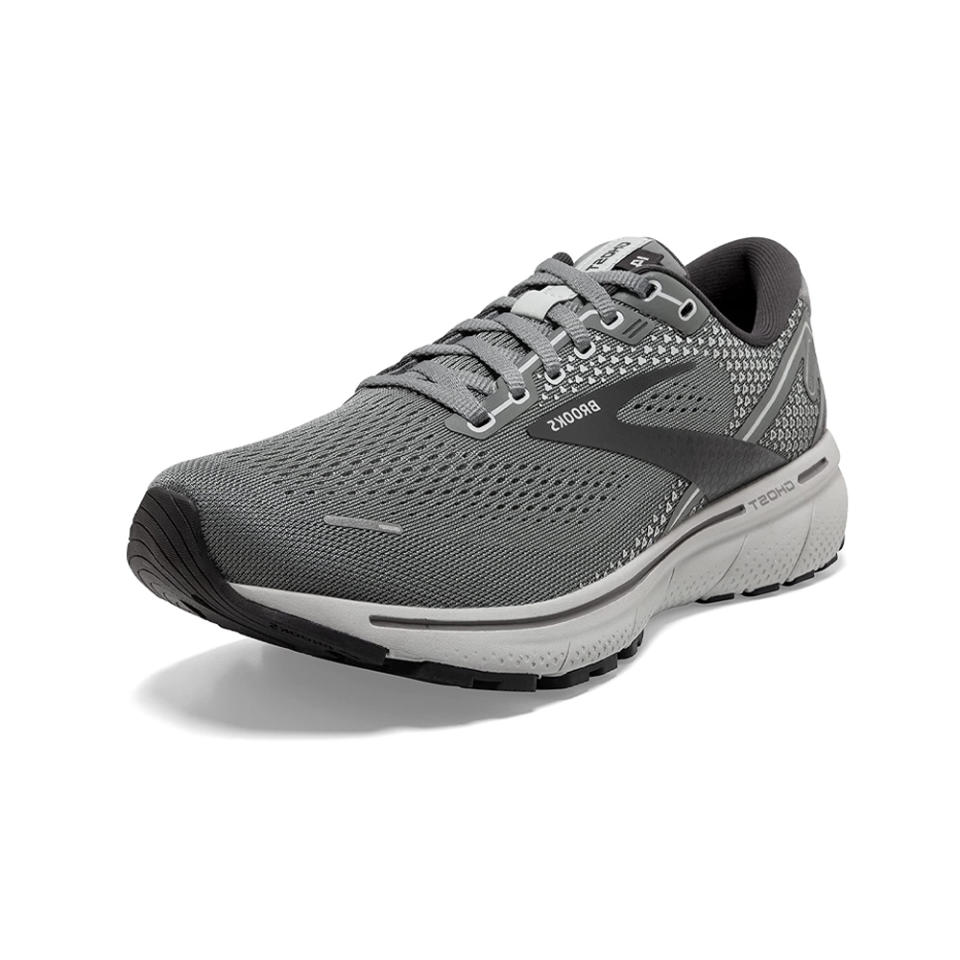
Courtesy of Amazon
Buy:
Brooks Men's Ghost 14 Wide
$115-$304
Buy:
Brooks Women's Ghost 14 Wide
$114-$362
Asics Metaspeed Sky Running Shoes
Best Carbon Fiber Plate Running Shoes
Now that the novelty of carbon fiber-plated running has worn off, it’s time to sort through the masses to find the true gems. Having tested all the carbon fiber shoes on the market, I would recommend only three: the Nike Alphafly Next%, Nike Vaporfly NEXT2% and Asics Metaspeed Sky. And the Asics Metaspeed Sky is the only model I’d recommend to all runners. The issue with Nike is, as the pace slows to under about seven minutes per mile, the shoes start to feel inherently unstable. On the other hand, the Asics Metaspeed Sky remains true to form even at slower paces, making it ideal for recreational and elite runners alike. As one age-experienced reviewer noted, “I’m 57 and not super fast, but these make an eight-minute mile a breeze for me.”
The magic comes from the combination of Asics’ highest-performing FF Blast Turbo midsole, a full-length carbon fiber plate and curved sole design that makes toeing off smooth and more powerful. A wider base and forefoot than what’s found in Nike’s version contributes to a more stable and reliable ride at both faster and slower paces. The pop-off-the-ground sensation of the FF Blast Turbo midsole is phenomenal.
If I had to call out one negative thing about the Metaspeed Sky it would be its rather stiff engineered mesh upper. While it offers excellent breathability, it feels stiff and scratchy against the foot. Not enough to irritate, but a softer-feeling upper would be a nice upgrade (something I believe is coming in the Metaspeed Sky 2). A word of caution about the fit: These run on the smaller side, so it’s best to size up if you are in between sizes.
Specs:
Weight: 7oz (men); 5.8oz women
Stack Height: 33mm/ 28mm
Drop: 5mm
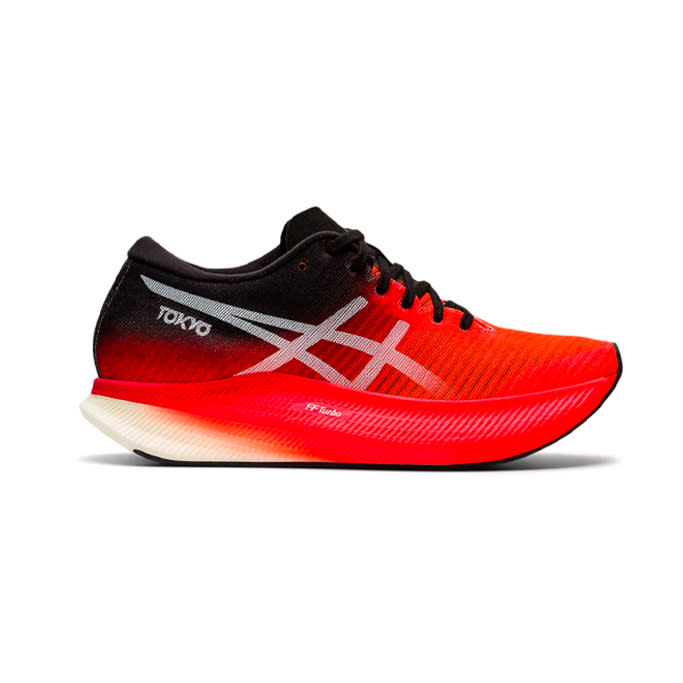
Courtesy of Asics
Buy:
Asics Men's Metaspeed Sky
$325
Buy:
Asics Women's Metaspeed Sky
$325
Nike Air Zoom Alphafly Next% Running Shoes
Best Marathon Racing Shoes
Racing a marathon is tough on the body. The 26.2 miles of pounding on concrete takes its toll on your legs, leaving them feeling like lead for those last miles. Save your legs, and perhaps a few minutes on your finishing time, with the ultra-cushioned Nike Air Zoom Alphafly Next%. These shoes are fast, furious and freaking fantastic.
If you haven’t tried them, I’ll warn you: At first, they feel as odd as they look. The thick, soft sole feels unstable and way too soft to be fast, but it actually saves a lot of energy. “The shoe is so responsive and soft,” noted one tester. “The next day I felt very little soreness.”
Meanwhile, two Nike Air Pods in the forefoot feel like mini-trampolines, bouncing you forward with each footstrike. “I’ve never had a shoe that just made my time goals effortless,” continued the same tester.
The hefty price tag is a cause for concern for many, but it can be justified by the fact that the Nike Air Zoom Alphafly Next% is unlike any shoe ever created. It’s such a unique experience, every runner should try them once.
Specs:
Weight 7.4oz (men); 6.5oz women
Stack Height: 40mm/ 36mm
Drop: 4mm
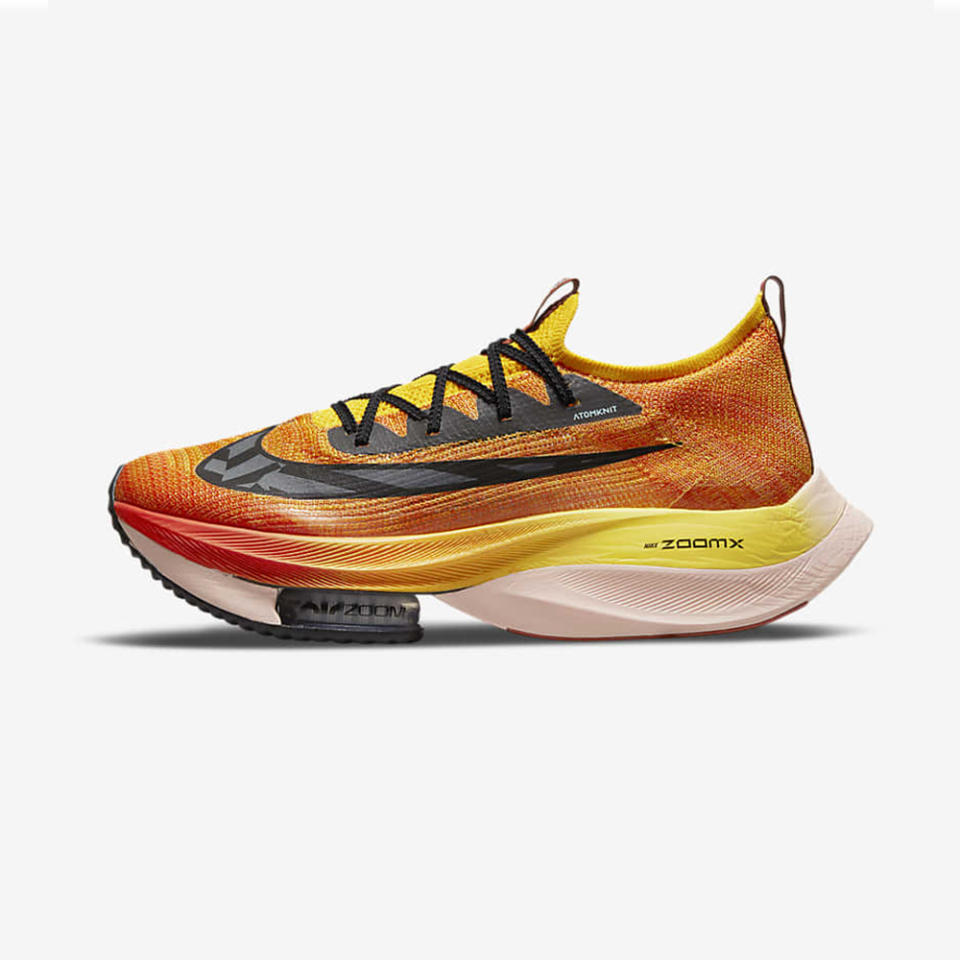
Courtesy of Nike
Buy:
Nike Men's Air Zoom Alphafly Next%
$285
Buy:
Nike Women's Air Zoom Alphafly Next%
$275
Skechers Speed Freak Running Shoes
Best for Speed Running
You might be thinking, “Skechers makes running shoes, and they’re good?” The answer is yes! Behind our top pick, the Asics Gel-Nimbus Lite 3, Skechers’ Speed Freak came in as the second-highest-ranking shoe. I can confirm this shoe is pretty spectacular, and it’s quickly become my go-to for speed sessions.
The highlight of the shoe is certainly Skechers’ award-winning Hyper Burst midsole foam. It’s bouncy as hell and hits on all cylinders of what a foam should be: lightweight, cushioned and responsive. One tester described it as “the softest springiest materials on the market.” Skechers didn’t skimp on the cushioning, either. The Speed Freak is thick-soled, with a 36 millimeter/32 millimeter stack height, to be exact. Sandwiched in the midsole is a carbon fiber-infused winglet plate, a wishbone-shaped plate that adds tough rigidity. All this is packed in a jaw-dropping weight of 7.2 ounces for men and 5.8 ounces for women. To have this level of cushioning and performance in such a lightweight shoe is not a small feat.
Unlike a lot of other tall stack height carbon fiber shoes, the Speed Freak is a stable shoe, perfectly at home ripping around corners or moving along at a leisurely pace. If you haven’t run in Skechers recently, $200 for the Speed Freak may seem like a lot. However, this is one of the less expensive carbon fiber shoes on the market. While it certainly doesn’t have the stardom of Nike, Asics, or Saucony super shoes, I can assure you it’s worth the price.
Specs:
Weight 7.2oz (men); 5.8oz women
Stack Height: 34mm/ 30mm
Drop: 4mm
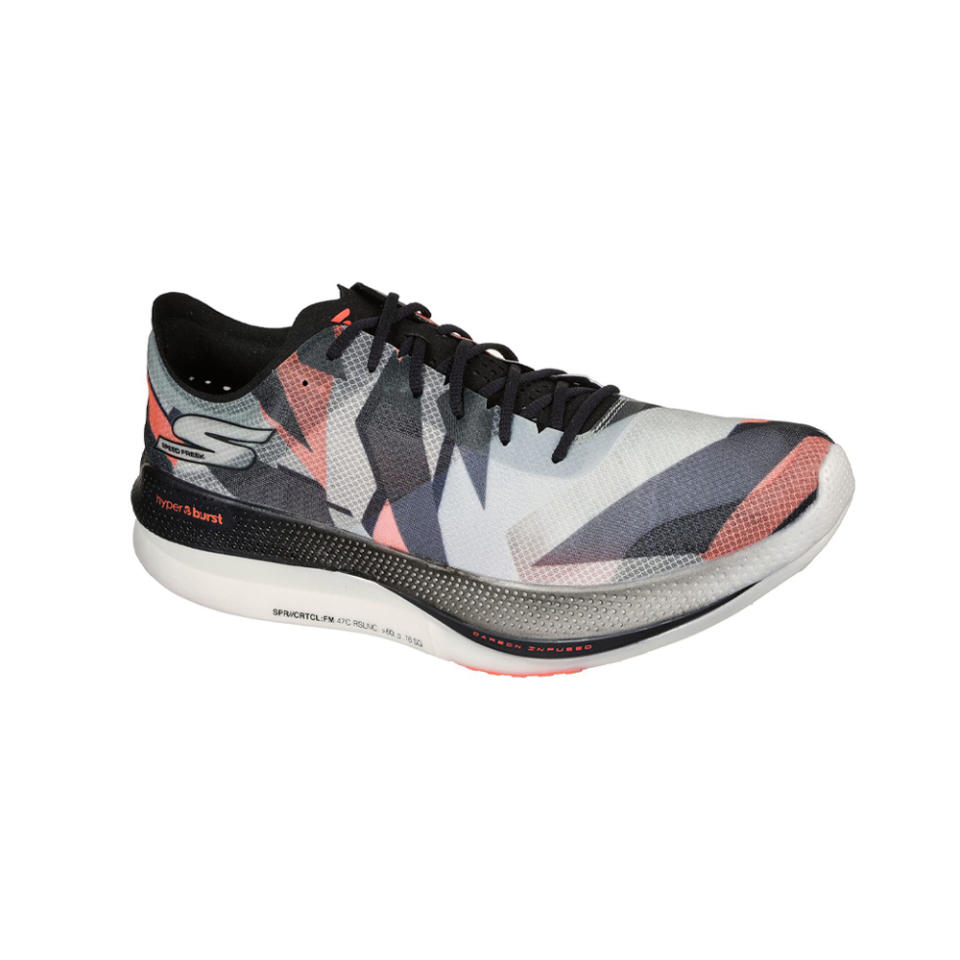
Courtesy of Skechers
Buy:
Skechers Men's Speed Freak
$200
Buy:
Skechers Women's Speed Freak
$189
Saucony Axon Running Shoes
Best Budget
Most running brands will cut corners for lower-priced running shoes and use a cheaper, less durable foam for the midsole. This is not the case with Saucony’s Axon, however. Priced at an attractive $100, the Axon features Saucony’s PWRRUN midsole that’s also seen in the more premium Saucony Ride 14, Kinvara 12 and Guide 14. With a 35 millimeter/31 millimeter stack height, the Axon is just two millimeters shorter than the thick-soled Hoka One One Bondi. All that foam provides great underfoot protection and durability.
If you’re looking for a super soft shoe, though, you may want to look elsewhere. The PWRRUN midsole runs on the firmer side for a maximum cushioned shoe even after a slight break-in period. Still, the firm feeling isn’t all bad. As one tester noted, “The foam performs exceptionally and provides a fast ride and toe-off.”
I was pleasantly surprised by how peppy the Axon felt. Thanks to its rocker geometry, the forefoot has an upward curve and heel-to-toe transitions are smooth and easy-going.
All in all, the Axon is a tried-and-true, no-frills everyday trainer that packs a punch for $100.
Specs:
Weight 9.3oz (men); 8.2oz women
Stack Height: 31mm/ 35mm
Drop: 4mm
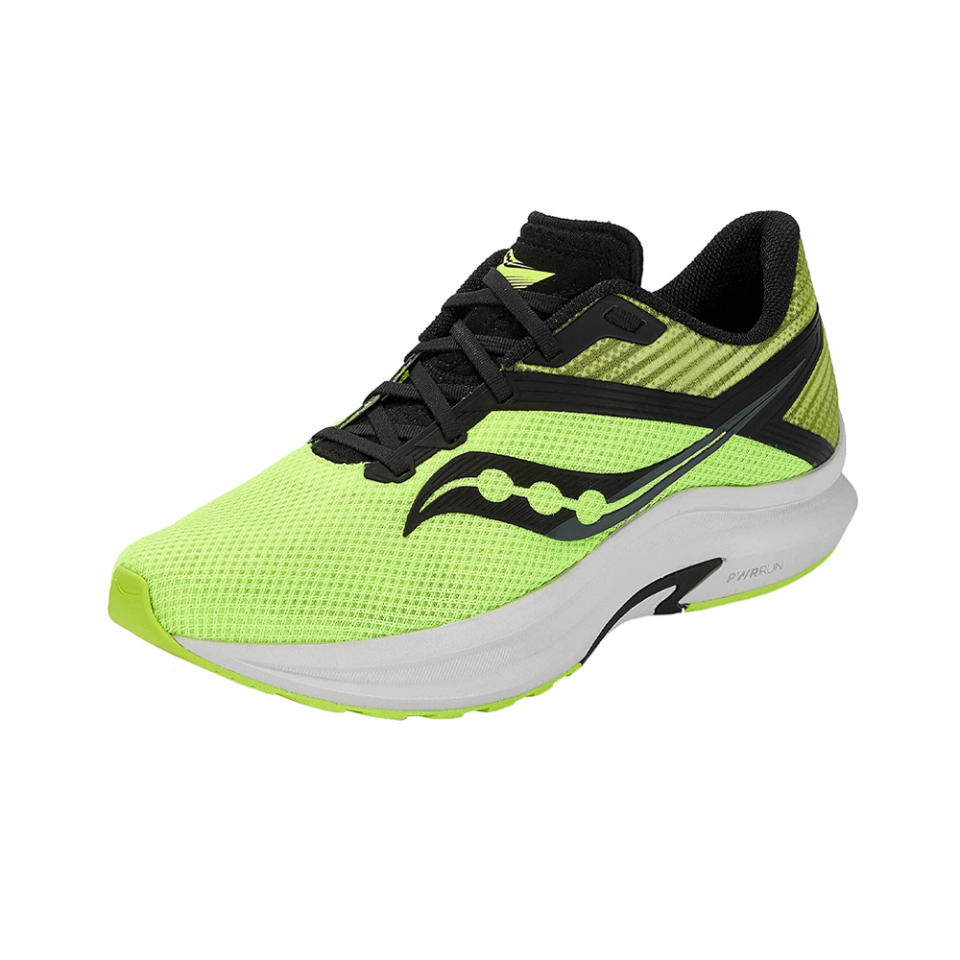
Courtesy of Amazon
Buy:
Saucony Men's Axon
$75-$164
Buy:
Saucony Women's Axon
$74-$180
Hoka One One Speedgoat 4 Running Shoes
Best Cushioned Trail Shoes
Named after famed ultrarunner Karl “Speedgoat” Meltzer, the Hoka Speedgoat 4 delivers unmatched comfort and performance for those marathon days in the mountains. Built with a massive 39.5 millimeter/35.5 millimeter stack height, the Speedgoat 4 has more cushioning and underfoot protection than any other trail shoe on the market. For days when my legs are sore and tired, and I just can’t take any more hard pounding, these are my go-to trail shoes. The soft, pillow-like cushioning is a godsend for my achy feet.
With that said, heavier runners may find they compress the uber-soft midsole too much over time. A firmer maximum cushioning shoe, such as the Hoka Mafente Speed 2, may be a better fit. If you haven’t experienced a Hoka running shoe, I highly suggest it. As one runner explains, “I’ve had a dozen pairs of different Brooks, tried Salomons, Altras, Inov8s, Reeboks, Asics and always had some nagging issues with them. After 400 miles on my newest Speedgoats, I don’t know if I’ll ever buy another brand.” For runners whose feet swell during ultras, check out the wide width option.
Specs:
Weight 10.8oz (men); 9.6oz women
Stack Height: 39.5mm/ 35.5mm
Drop: 4mm
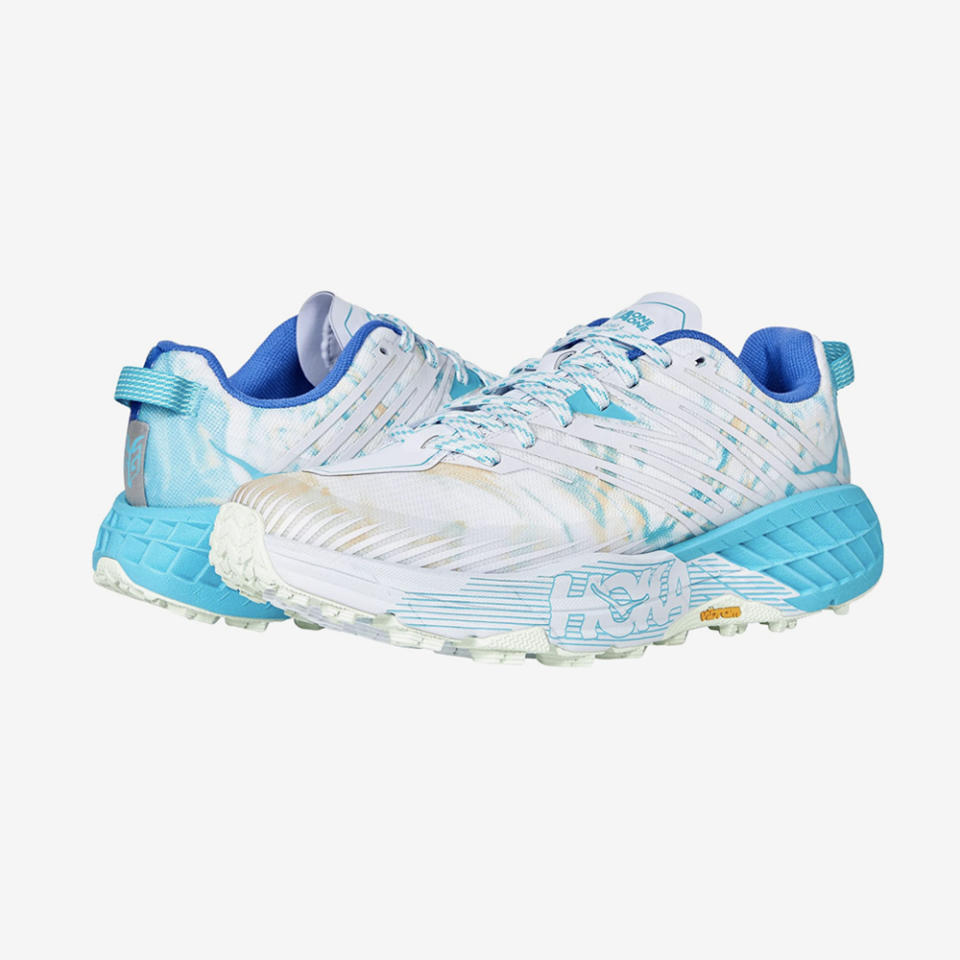
Courtesy of Zappos
Buy:
Hoka One One Men's Speedgoat 4
$144
Buy:
Hoka One One Women's Speedgoat 4
$144
When to replace your running shoes
Ah, the million-dollar question. Unfortunately, If you’re looking for a universal quantitative standard, I’m sorry to say there isn’t one. In general, you can expect to get anywhere from 200 to 500 miles out of your shoes, depending on how they’re made, before you have to replace them.
“There are a lot of factors that go into shoe durability,” explains Scott Tantino, owner of two running specialty stores outside Philadelphia. “The first is the amount of cushioning built into the shoe. After that, the runner needs to take into account their injury history, height, weight, and surface.”
“It’s a good idea for runners to do an ache and pain inventory as their shoe ages,” he adds. He suggests asking yourself if any aches and pains are creeping up that weren’t bothering you the week before. This could indicate that the integrity of the foam has been worn out and is not providing adequate cushioning anymore.
Soles that are worn-down or have crease lines are also excellent cues that it’s time to retire a pair of running shoes. I’ve personally found the best way to know if it’s time to replace a pair of running shoes is when you find yourself asking that question.
Best of Footwear News
The 14 Best Cross-Training Shoes for Men, As Tested by a Fitness Enthusiast
The 10 Best Long-Distance Running Shoes, According to a Distance Running Coach
Sign up for FN's Newsletter. For the latest news, follow us on Facebook, Twitter, and Instagram.

